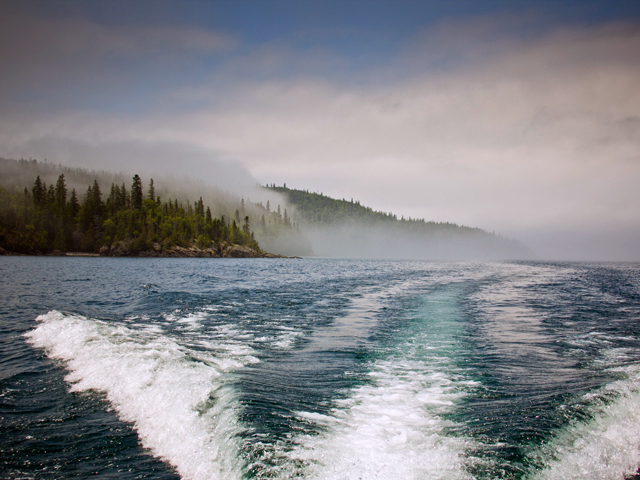Mike and I lay on our elbows at 2am, half asleep and eyes glued to the sky as the entire length of the horizon exploded in a red glow, over and over. The black clouds above Lake Superior were backlit by the moon, the lightning illuminating only a sliver where the water met the sky. The wind was warm, but ripping off the water and tugging violently at the canvas covering the tent trailer. We must have lain there for 20 minutes, just watching, and exclaiming gently at the occasional white lightning bolt, before the rain came and we zipped up the windows and fell back asleep.
By noon, we weren’t sure how our planned boat tour of the Slate Islands would unfold – mist rolled over the highway on the way to Terrace Bay from Neys, and the water was all but completely obscured with fog cover. We met Captain Come Castongauy of Bluebird Charters at the Terrace Bay dock, and headed out on the 20km crossing. There was fog all around and for most of the trip we couldn’t see any land anywhere. But as we rounded the point and cruised into the sheltered bays, the fog rolled away like magic, and the sky was blue and bright.
The Slate Islands are home to a large herd of woodland caribou, a species at risk in Ontario. Captain Come told us that about 60 years ago, the caribou arrived on the islands by crossing the ice on the frozen lake. But that part of Lake Superior didn’t freeze the next winter, or the next… and 60 years later, the caribou are still stranded. But they have no natural predators on the islands and there is no hunting allowed, so the species will probably stick around for a while.
We arrived at Fisherman’s Cove, a tiny little clearing with a dock, where Bluebird Charters drops off campers who want to stay for a few days, with their canoes, kayaks and camping gear. There were caribou tracks on the beach, but no animals. After exploring a dilapidated old fishing shack and investigating the woods for caribou poop, we headed out to the shattercones – 450 million year old remnants of a meteor strike, basically the solidified form of an instantaneous volcano, eroded by time. To an untrained eye, though, they just look like a big reddish rock cliff. But knowing the story makes it seem kind of surreal — to imagine that a 19km wide meteor slammed into the earth exactly where your boat is drifting, and that gigantic wall of rock was its molten backsplash. It’s pretty amazing.
Our last stop was a decommissioned lighthouse high on the cliffs on the big water side of the Slates. Captain Come sent us up a lush green path behind the beautiful old lighthouse-keeper’s cottage — past monstrous rhubarbs and a burbling freshwater brook — that lead us up to the light on the flat rocks at the top of the cliff. An abandoned red-roofed fishing village huddled on the beach down below. The view was breathtaking, almost coastal – like, ocean coastal – in feel. The other day, Bogdan, who had never seen Lake Superior before, said, “if you told me that was the ocean, I’d believe you.” And up on that cliff, I’d believe it too.
As the sun lost its fury, we made our way to the tiny Rossport campground in Rainbow Falls provincial park, our last night of camping on Lake Superior. It’s a lovely little spot, with spacious grassy sites right at the water’s edge. The smooth, rounded red rocks and windblown white spruce silhouetted in the rosy sunset — as the moon rose over the the rocks across the bay — were the quintessential image of Lake Superior’s shoreline. In the dark, the full moon reflecting on the water and Mike’s campfire were the only lights we could see.
Well, that and his iPhone. Total coverage!
Tomorrow — We head for Sleeping Giant, and Mike risks his life on the Eagle Canyon zipline!
Photo by Alexandra Sawicki












Speak Your Mind